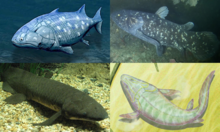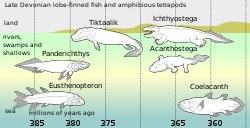ปลาที่มีครีบเป็นพู่
| ปลาที่มีครีบเป็นพู่ ช่วงเวลาที่มีชีวิตอยู่: 423–0Ma[1] ยุคไซลูเรียนตอนปลาย ถึง ปัจจุบัน | |
|---|---|

| |
| ปลาที่มีครีบเป็นพู่หลายตัว: Neoceratodus forsteri, Guiyu oneiros, Psarolepis romeri และ tetrapodomorph Panderichthys rhombolepis. | |
| การจำแนกชั้นทางวิทยาศาสตร์ | |
| อาณาจักร: | Animalia |
| ไฟลัม: | Chordata |
| ไฟลัมย่อย: | Vertebrata |
| ชั้นใหญ่: | Osteichthyes |
| ชั้น: | Sarcopterygii Romer, 1955 |
| ชั้นย่อย | |
| |
ปลาที่มีครีบเป็นพู่ หรือ ปลาครีบเป็นพู่ (อังกฤษ: Lobe-finned fishes) เป็นปลาที่อยู่ในชั้นใหญ่ Sarcopterygii (มาจากภาษากรีกคำว่า σαρξ (sarx), "เนื้อ" และ πτερυξ (pteryx), "ครีบ") หรือในบางครั้งอาจใช้ชื่อว่า Crossopterygii (แปลว่า "Fringe-finned fish", มาจากภาษากรีก κροσσός krossos, "ชายขอบ")
เป็นปลาที่มีลักษณะแตกต่างจากปลาในชั้นอื่น ๆ คือ มีเกล็ดเป็นแบบ Cosmoid มีลักษณะเฉพาะ คือ ครีบที่บริเวณหน้าอกวิวัฒนาการจากครีบธรรมดา ๆ มาเป็นเสมือนอวัยวะที่ใช้เคลื่อนไหวได้เหมือนการเดินในน้ำ โดยลักษณะของครีบจะเป็นพู่เนื้อหรือเนื้อเยื่อ มีความแข็งแรงมาก โดยมีแกนกระดูก จึงเป็นเสมือนรอยต่อของการวิวัฒนาการของปลาซึ่งเป็นสัตว์น้ำอาศัยอยู่ในน้ำได้อย่างเดียว ขึ้นมาอยู่บนบกกลายเป็นสัตว์ครึ่งบกครึ่งน้ำก่อนจะวิวัฒนาการเป็นสัตว์เลื้อยคลานและสัตว์ในชั้นอื่น ๆ ต่อไป
ปลาที่มีครีบเป็นพู่ ถือกำเนิดมาในยุคซิลูเรียนตอนปลาย (418 ล้านปีก่อน) ในทะเลและค่อยคืบคลานสู่แหล่งน้ำจืดที่มีลักษณะเป็นหนองหรือคลองบึง สันนิษฐานว่าการที่พัฒนาเช่นนี้ คงเป็นเพราะต้องการหนีจากปลาที่เป็นปลากินเนื้อขนาดใหญ่ที่ครองพื้นที่ทะเลในขณะนั้น เช่น ดังเคิลออสเตียส เป็นต้น
ปัจจุบัน ปลาในชั้นนี้ได้สูญพันธุ์หมดแล้ว คงเหลือไว้เพียง 2 จำพวกเท่านั้น คือ ปลาซีลาแคนท์ ที่ครั้งหนึ่งเคยเชื่อว่าสูญพันธุ์ไปแล้ว กับปลาปอด ที่กลายมาเป็นปลาน้ำจืดอย่างถาวร และได้มีพัฒนาถุงลมที่ใช้ในการว่ายน้ำและทรงตัวเหมือนปลาทั่วไป กลายเป็นอวัยวะที่ใช้ในการหายใจคล้ายกับปอดของสัตว์บก สามารถแลกเปลี่ยนออกซิเจนได้เป็นอย่างดี จึงทำให้อาศัยอยู่ในแหล่งน้ำที่คุณภาพน้ำแย่ มีปริมาณออกซิเจนต่ำได้[2]

การจำแนก
[แก้]- ชั้นย่อย Sarcopterygii
- †อันดับ Onychodontida
- อันดับ Actinistia
- ชั้นฐาน Dipnomorpha
- †อันดับ Porolepiformes
- ชั้นย่อย Dipnoi
- อันดับ Ceratodontiformes
- อันดับ Lepidosireniformes
- ชั้นฐาน Tetrapodomorpha
- †อันดับ Rhizodontida
- อันดับใหญ่ Osteolepidida
- †อันดับ Osteolepiformes
- †วงศ์ Tristichopteridae
- †อันดับ Panderichthyida
- ชั้นใหญ่ Tetrapoda
- †อันดับ Osteolepiformes
ดูเพิ่ม
[แก้]อ้างอิง
[แก้]- ↑ Brazeau, Martin D.; Friedman, Matt (April 23, 2015). "The origin and early phylogenetic history of jawed vertebrates". Nature. 520 (7548): 490–7. Bibcode:2015Natur.520..490B. doi:10.1038/nature14438. PMC 4648279. PMID 25903631.
- ↑ ต้อยตีวิด, ‘ซีลาแคนธ์’ปลาตีนยุคแรก คอลัมน์ สัตว์โลกน่ารัก นิตยสารโลกวันนี้วันสุข ปีที่ 5 ฉบับที่ 218 วันที่ 1-7 สิงหาคม พ.ศ. 2552 หน้า 49
Text is available under the CC BY-SA 4.0 license; additional terms may apply.
Images, videos and audio are available under their respective licenses.
